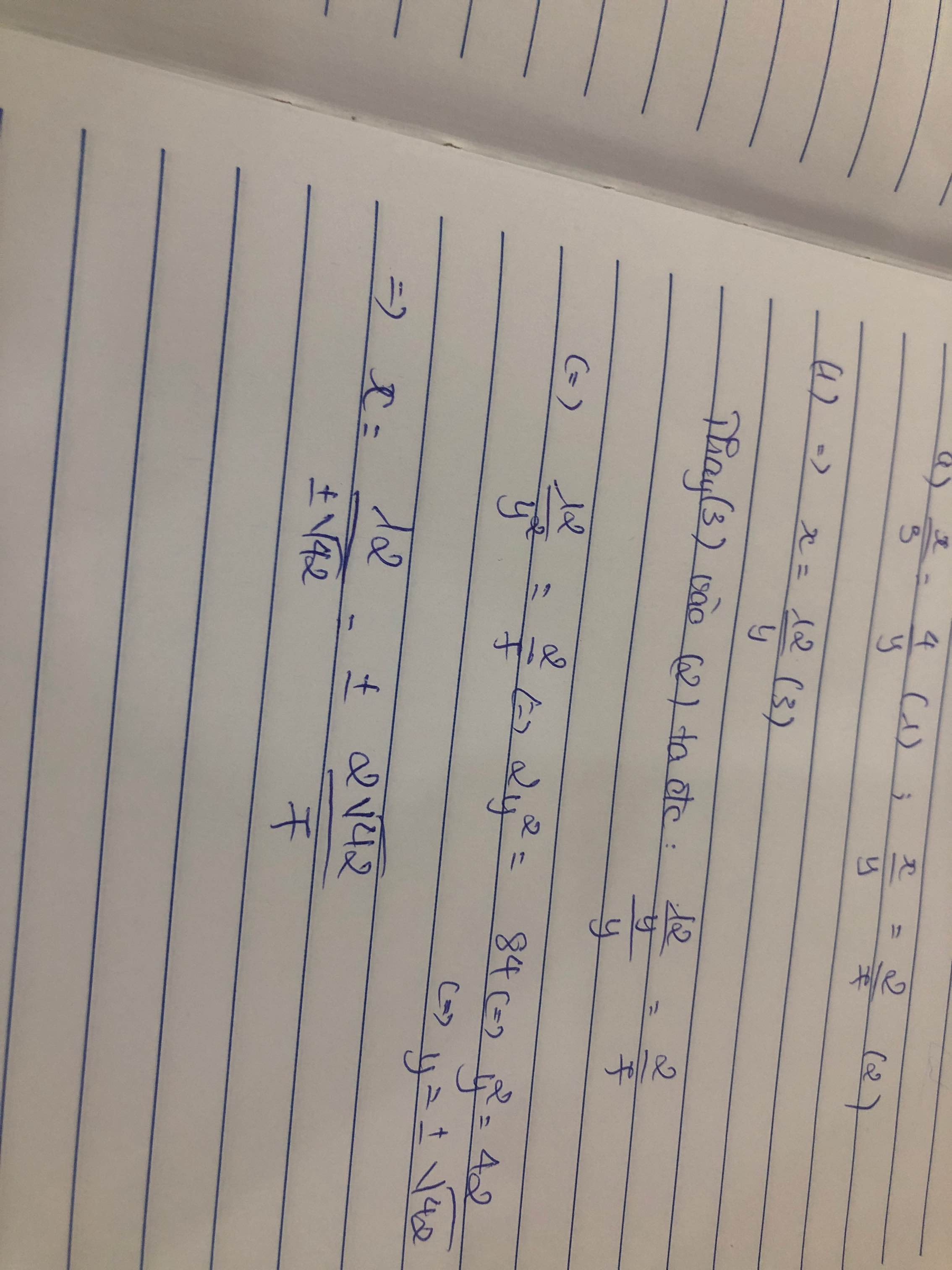Tìm các cặp số nguyên x, y biết:
\(\dfrac{5}{x}-\dfrac{4}{3}=x\)
Hãy nhập câu hỏi của bạn vào đây, nếu là tài khoản VIP, bạn sẽ được ưu tiên trả lời.


\(\Leftrightarrow\dfrac{xy-12}{4y}=\dfrac{5}{8}\)
=>2(xy-12)=5y
=>2xy-24=5y
=>2xy-5y=24
=>y(2x-5)=24
mà x,y là số nguyên
nên \(\left(2x-5;y\right)\in\left\{\left(1;24\right);\left(-1;-24\right);\left(3;8\right);\left(-3;-8\right)\right\}\)
=>\(\left(x,y\right)\in\left\{\left(3;24\right);\left(2;-24\right);\left(4;8\right);\left(1;-8\right)\right\}\)

Lời giải:
$\frac{2}{x}+\frac{y}{3}=\frac{1}{6}$
$\frac{6+xy}{3x}=\frac{1}{6}$
$\frac{2(6+xy)}{6x}=\frac{x}{6x}$
$\Rightarrow 2(6+xy)=x$
$\Rightarrow 12+2xy-x=0$
$12=x-2xy$
$12=x(1-2y)$
$\Rightarrow 1-2y$ là ước của $12$
Mà $1-2y$ lẻ nên $1-2y$ là ước lẻ của $12$
$\Rightarrow 1-2y\in\left\{\pm 1; \pm 3\right\}$
$\Rightarrow y\in\left\{0; 1; 2; -1\right\}$
$\Rightarrow x\in\left\{12; -12; -4; 4\right\}$ (tương ứng)

\(\dfrac{x}{3}\) + \(\dfrac{1}{2}\) = \(\dfrac{1}{y+3}\) Đk (\(y\ne-3\))⇒ \(\dfrac{2x+3}{6}\) = \(\dfrac{1}{y+3}\) ⇒ (2\(x\)+3)(y+3) = 6
Ư(6) = { -6; -3; -2; -1; 1; 2; 3; 6}
Lập bảng ta có:
| 2\(x\) +3 | -6 | -3 | -2 | -1 | 1 | 2 | 3 | 6 |
| \(x\) | -9/2 | -3 | -5/2 | -2 | -1 | -1/2 | 0 | \(\dfrac{3}{2}\) |
| y+3 | -1 | -2 | -3 | -6 | 6 | 3 | 2 | 1 |
| y | -4 | -5 | -6 | -9 | 3 | 0 | -1 | -2 |
Từ bảng trên ta có các cặp \(x\), y nguyên thỏa mãn đề bài là:
(\(x\), y) = ( -3; -5); ( -2; -9); ( -1; 3); (0; -1);

\(\dfrac{1}{x}+\dfrac{1}{y}=\dfrac{1}{3}\)=>\(\dfrac{x+y}{xy}=\dfrac{1}{3}\)
=>3(x+y)=xy
=>3x+3y=xy
=>3x=xy-3y
=>3x=y(x-3)
=>y=\(\dfrac{3x}{x-3}\)
* Vì y nguyên nên 3x ⋮ x-3
=>3(x-3)+9 ⋮x-3
=>9 ⋮ x-3
=>x-3∈Ư(9)
=>x-3∈{1;-1;3;-3;9;-9}
=>x∈{4;2;6;0;12;-6} mà x nguyên dương và x khác 0 nên x∈{4;2;6;12}
=>y∈{12;-6;6;4} mà y nguyên dương nên y∈{12;6;4}
=>x∈{4;6;12}
- Vậy x=4 thì y=12 ; x=6 thì y=6 ; x=12 thì y=4.

a, \(\dfrac{x}{2}=-\dfrac{5}{y}\Rightarrow xy=-10\Rightarrow x;y\inƯ\left(-10\right)=\left\{\pm1;\pm2;\pm5;\pm10\right\}\)
| x | 1 | -1 | 2 | -2 | 5 | -5 | 10 | -10 |
| y | -10 | 10 | -5 | 5 | -2 | 2 | -1 | 1 |
c, \(\dfrac{3}{x-1}=y+1\Rightarrow\left(y+1\right)\left(x-1\right)=3\Rightarrow x-1;y+1\inƯ\left(3\right)=\left\{\pm1;\pm3\right\}\)
| x - 1 | 1 | -1 | 3 | -3 |
| y + 1 | 3 | -3 | 1 | -1 |
| x | 2 | 0 | 4 | -2 |
| y | 2 | -4 | 0 | -2 |
b: =>xy=12
\(\Leftrightarrow\left(x,y\right)\in\left\{\left(12;1\right);\left(6;2\right);\left(4;3\right)\right\}\)

\(\dfrac{x}{3}-\dfrac{2}{y}=\dfrac{1}{2}\\ \Rightarrow\dfrac{2}{y}=\dfrac{x}{3}-\dfrac{1}{2}\\\Rightarrow \dfrac{2}{y}=\dfrac{2x-3}{6}\\ \Rightarrow y\left(2x-3\right)=2\cdot6\\ \Rightarrow y\left(2x-3\right)=12\)
mà `y in ZZ;x in ZZ`
`=>y in ZZ;2x-3 in ZZ`
`=>y;2x-3` thuộc ước nguyên của `12`
`=>y;2x-3 in {+-1;+-2;+-3;+-4;+-6;+-12}`
Ta có bảng sau :
| `y` | `-1` | `-2` | `-3` | `-4` | `-6` | `-12` | `1` | `2` | `3` | `4` | `6` | `12` |
| `2x-3` | `-1` | `-2` | `-3` | `-4` | `-6` | `-12` | `1` | `2` | `3` | `4` | `6` | `12` |
| `x` | `1` | `1/2` | `0` | `-1/2` | `-3/2` | `-9/2` | `2` | `5/2` | `3` | `7/2` | `9/2` | `15/2` |
Vì `x;y in ZZ`
nên `(x;y)=(1;-1);(0;-3);(2;1);(3;3)`


Ta thấy \(2x^2< 4\) \(\Leftrightarrow x^2< 2\) \(\Leftrightarrow x^2=1\) (do \(x\ne0\))
Thế vào pt đề bài, ta có \(3+\dfrac{y^2}{4}=4\)
\(\Leftrightarrow\dfrac{y^2}{4}=1\)
\(\Leftrightarrow y^2=4\)
\(\Leftrightarrow y=\pm2\)
Vậy, các cặp số (x; y) thỏa ycbt là \(\left(1;2\right);\left(-1;-2\right);\left(1;-2\right);\left(-1;2\right)\)
